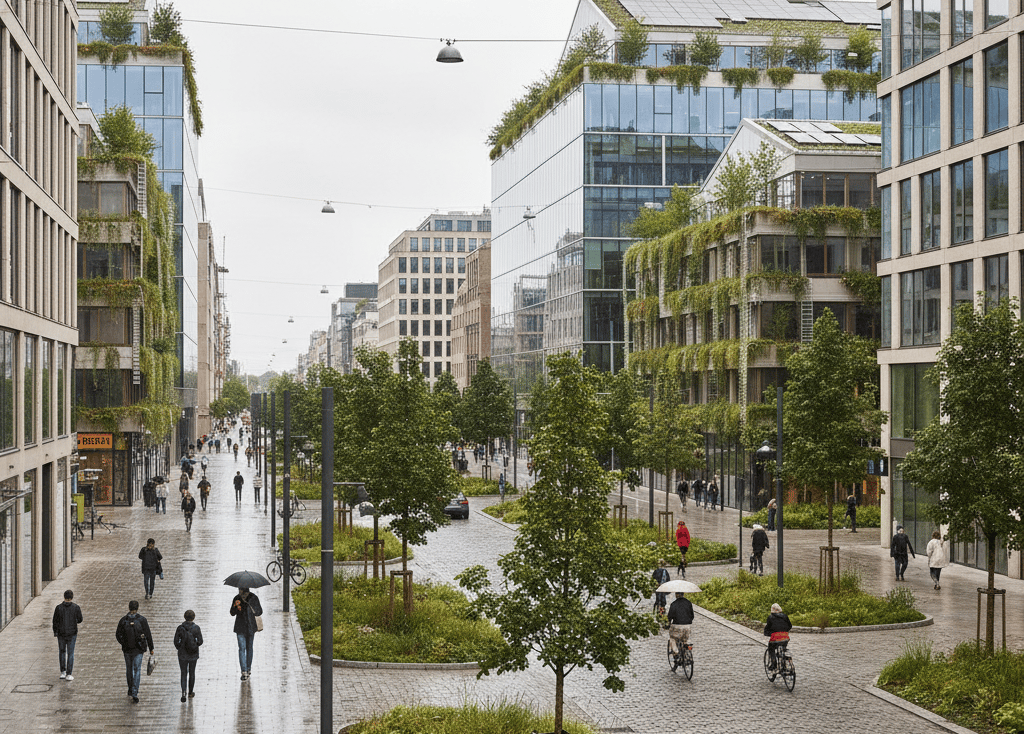Quality and technology IN CONSTRUCTION
delivered with STRAIGHT communication
Architecture Built to Outlast the Century – Rethinking Regulation and Economic Models in the Age of Climate Change
Architecture today is about survival, not style. Germany, Switzerland, and Singapore prove that climate-adaptive building is law and opportunity. Hungary must break its legislative inertia and create adaptive regulations—otherwise, the climate will rewrite our future for us.
CONSTRUCTIONTRENDPROJECTMANAGEMENTFUTURESUSTAINABILITY
Dr. Toldy Gábor - Toldy Construct
10/20/20253 min read


Survival Is No Longer an Aesthetic Question
The architecture of the 21st century will no longer be defined by style or form, but by the capacity to survive. Climate change does not wait for political cycles—coastal cities are drowning, Mediterranean regions are facing record-breaking heat waves every year, and the built environment has become both highly vulnerable and critically important.
Adaptation is no longer an architectural matter; it is a legal and economic imperative. Failing to recognize this in time does not merely cost market opportunities—it jeopardizes the safety of future generations.
Hungary’s current regulatory framework — the Building Act (Étv.) and its related decrees — still operate under a 20th-century mindset: reactive, not proactive. While Western Europe and parts of Asia have already integrated climate risk assessments into their construction laws, in Hungary adaptation remains confined to the vague realm of “environmental awareness.”
Germany: Adaptive Regulation That Protects the Economy
Germany was among the first countries to embed climate adaptation into its building legislation. The updated Federal Climate Adaptation Strategy (Bundes-Klimaanpassungsstrategie) of 2021 made it mandatory for new construction permits to undergo thermal and hydrological stress assessments.
The Baugesetzbuch (BauGB)—Germany’s Building Code—was amended in 2022 to empower municipalities to set green infrastructure quotas: every new residential or industrial development must include a specified share of green roofs, shade-providing trees, or rainwater retention systems.
Economic incentives followed suit. The KfW Bankengruppe launched its Klimaschutz im Gebäudebereich program, providing over €10 billion by 2024 to support energy-efficient, low-emission, and water-saving building technologies. In Germany, adaptation has become both a legal obligation and a business opportunity.
Switzerland: Decentralized Climate Consciousness as a Model
In Switzerland, construction regulation operates at the cantonal level, yet standards such as SIA 380/1 and SIA 112/2 have long required architects to consider local climate impacts in their designs.
The Swiss approach is unique in that it takes a bottom-up perspective: adaptation is driven not by federal decrees but by professional chambers and municipalities.
Since 2019, the Zurich Chamber of Architects has mandated climate risk assessments for all public buildings. Construction permits are granted only if a design demonstrably mitigates heat load and energy demand.
Switzerland’s economic model is built not on subsidies but on the market power of quality standards. Adaptive building design is not the exception—it is the baseline expectation.
Singapore: When the State Moves Faster Than the Weather
In Singapore, climate adaptation is not optional. Since 2010, the country has implemented the world’s most comprehensive urban climate adaptation program—the ABC Waters Programme—integrating water management, green space, and urban design into a single system.
Under the Urban Redevelopment Authority (URA) regulations, all new developments must incorporate water retention, cooling, and green infrastructure to combat the urban heat island effect.
The 2021 Singapore Green Plan 2030 took this further: major developers receive tax and permit incentives if their buildings achieve Green Mark Platinum certification—proof of climate resilience, energy efficiency, and low carbon emissions.
The results are measurable: in just 15 years, Singapore’s energy efficiency index improved by 35%, and temperatures in newly built districts are 2–3°C lower than in traditionally constructed areas.
Hungary: Where Regulations Age Faster Than the Buildings
Hungary’s construction laws and economic incentives still treat climate change reactively. The Étv.—originally passed in 1997—remains anchored in the economic logic of the 1990s, while the rest of the world is designing under “net-zero” strategies.
The National Building Energy Strategy (2015) is now obsolete, and the OTÉK (National Building and Urban Development Code) still lacks explicit requirements for climate-adaptive design.
This legislative inertia—a culture of immobility—is one of the greatest obstacles. The state should not merely regulate; it must create a market for adaptation through green tax incentives, preferential treatment in public tenders, and targeted R&D programs.
The construction industry directly contributes 5–6% to Hungary’s GDP but influences up to 15% of the broader economy. This means that transitioning to adaptive construction is not a cost—it is a macroeconomic investment in stability, resilience, and sustainability.
Conclusion: The Cost of Action Is Lower Than the Cost of Inaction
Architecture mirrors society—and today, that reflection shows a culture still delaying the inevitable.
Germany, Switzerland, and Singapore have already proven that climate adaptation is not idealism but a matter of legislative courage. Hungary has the intellectual and technical capacity to follow suit, but what is missing is the political and legislative will.
Architecture that outlasts the century will not be defined by aesthetics or technology, but by reason and responsibility.
The only remaining question is whether we will wait for the climate to rewrite our laws—or have the foresight to write ourselves into the future.
Sources
Bundesministerium für Umwelt, Naturschutz, nukleare Sicherheit und Verbraucherschutz: Deutsche Anpassungsstrategie an den Klimawandel, 2021.
KfW Bankengruppe: Klimaschutz im Gebäudebereich – Förderprogramme 2024.
Schweizer Ingenieur- und Architektenverein (SIA): SIA 380/1 Energie im Hochbau, Zurich, 2020.
Urban Redevelopment Authority (URA), Singapore: Green Plan 2030 & ABC Waters Design Guidelines, 2022.
OECD (2023): Climate-Resilient Infrastructure: Policy Perspectives.
European Commission: EU Strategy on Climate Adaptation, 2021.
Construction
With over 20 years of experience in general contracting, our company specializes in the flawless execution of unique, bespoke buildings. Our innovative methods and mindset make us stand out in the market.
Our services
Contacts
company@toldyconsult.hu
+36 30 289 2383
© 2024. All rights reserved.
Our WEBPAGES
www.toldyconsult.hu
